Performance Analysis of FOODplus: An Australian supermarket chain using annual survey data
VerifiedAdded on 2023/04/22
|6
|2312
|138
AI Summary
Contribute Materials
Your contribution can guide someone’s learning journey. Share your
documents today.
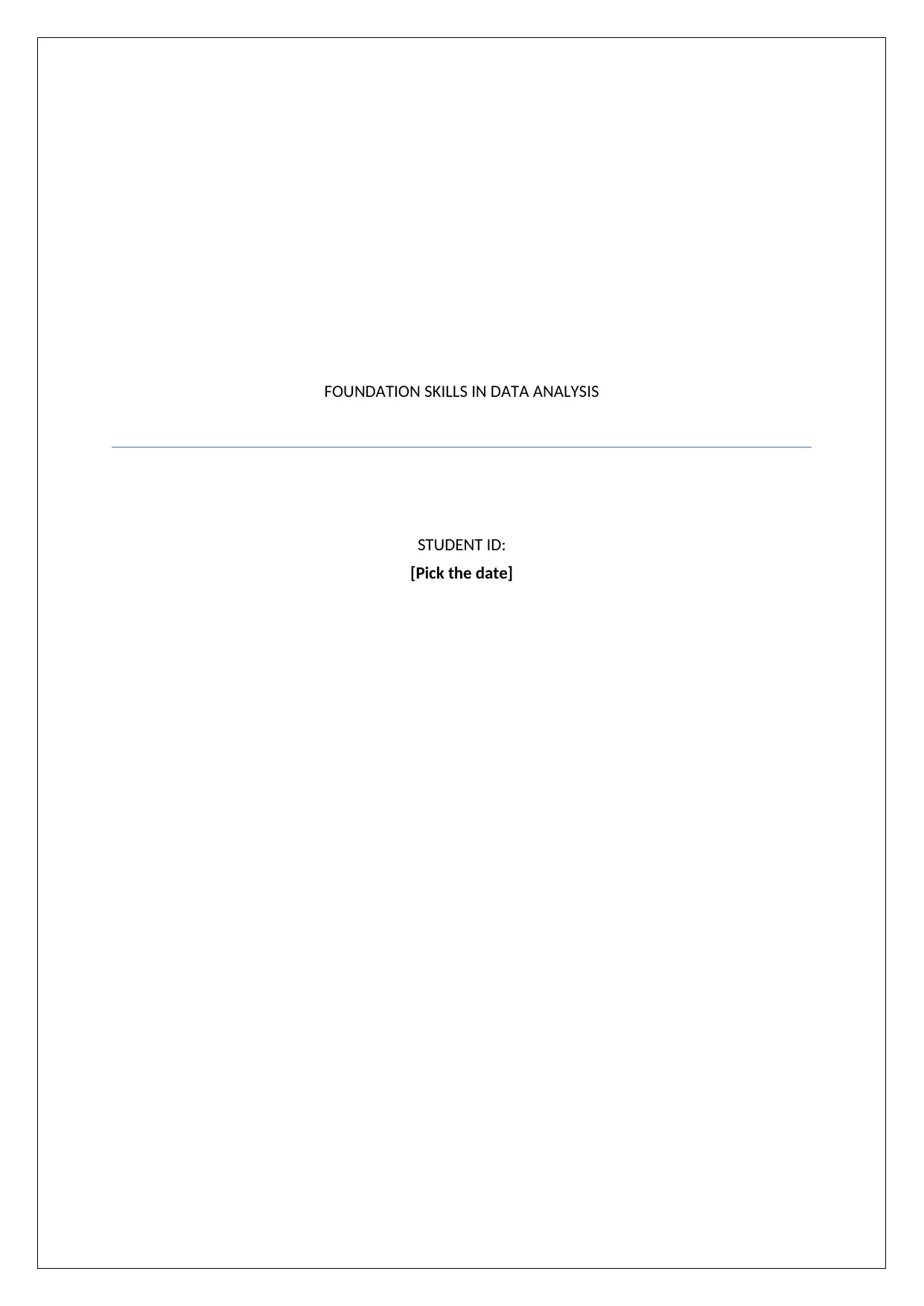
FOUNDATION SKILLS IN DATA ANALYSIS
STUDENT ID:
[Pick the date]
STUDENT ID:
[Pick the date]
Secure Best Marks with AI Grader
Need help grading? Try our AI Grader for instant feedback on your assignments.
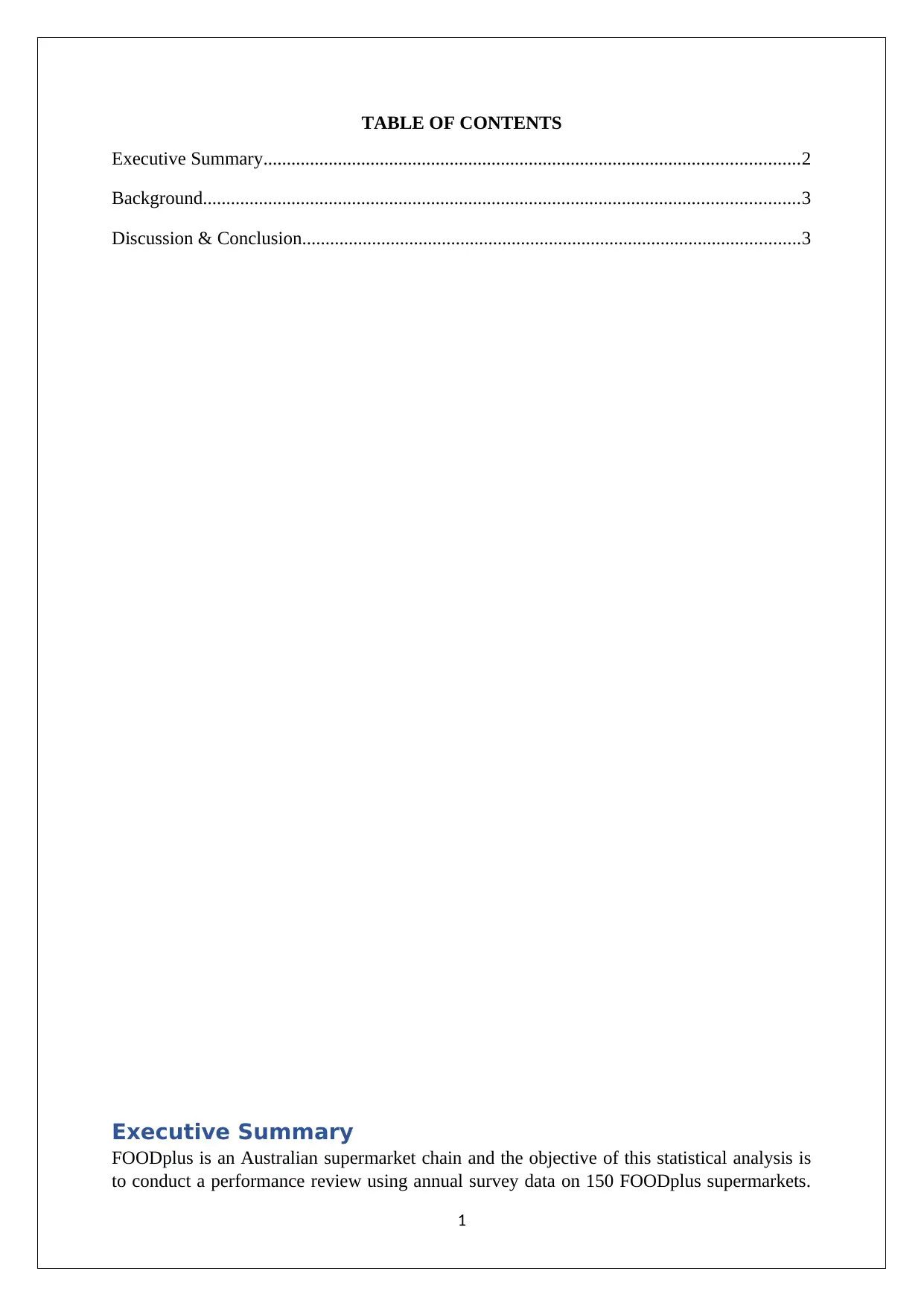
TABLE OF CONTENTS
Executive Summary...................................................................................................................2
Background................................................................................................................................3
Discussion & Conclusion...........................................................................................................3
Executive Summary
FOODplus is an Australian supermarket chain and the objective of this statistical analysis is
to conduct a performance review using annual survey data on 150 FOODplus supermarkets.
1
Executive Summary...................................................................................................................2
Background................................................................................................................................3
Discussion & Conclusion...........................................................................................................3
Executive Summary
FOODplus is an Australian supermarket chain and the objective of this statistical analysis is
to conduct a performance review using annual survey data on 150 FOODplus supermarkets.
1
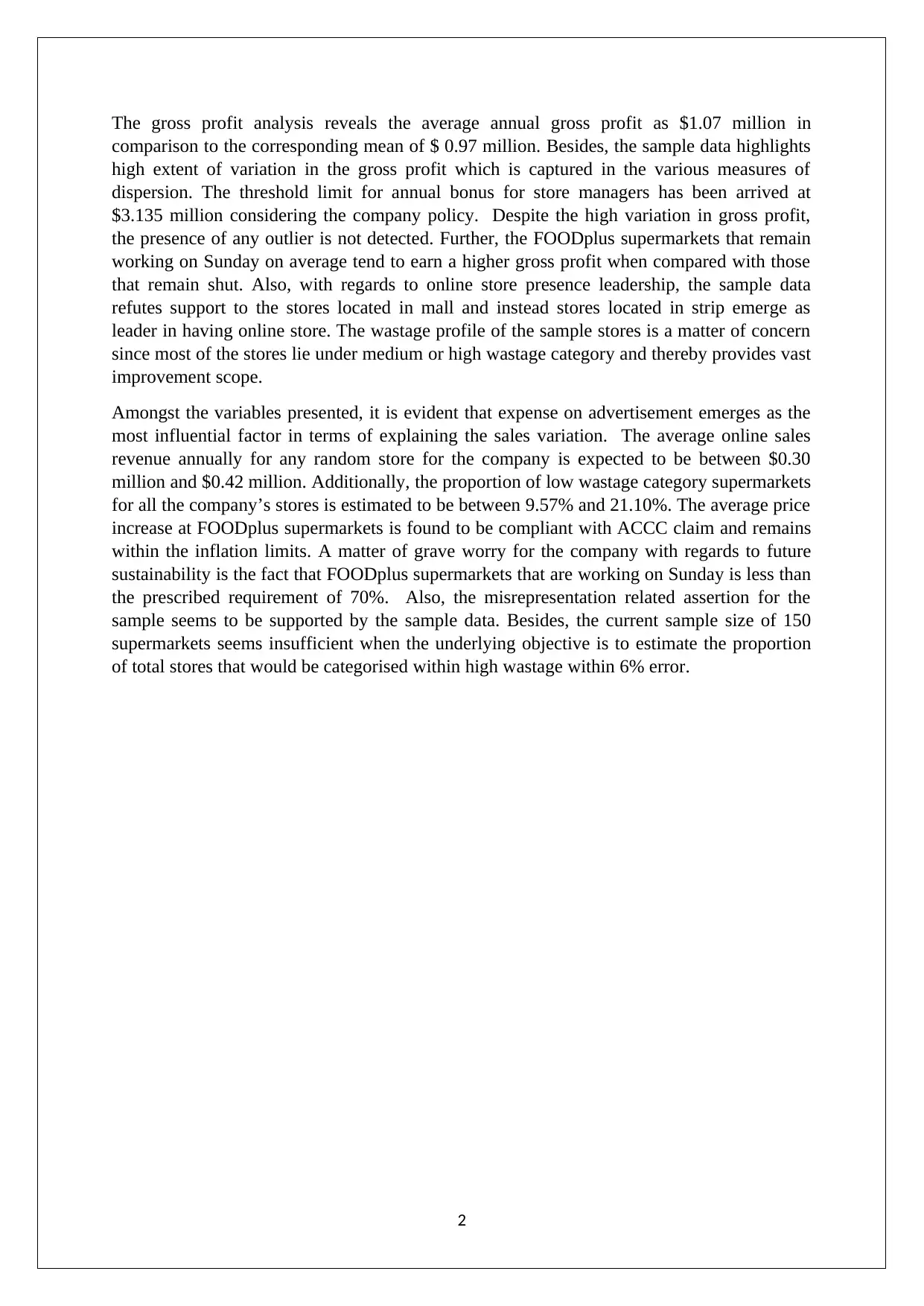
The gross profit analysis reveals the average annual gross profit as $1.07 million in
comparison to the corresponding mean of $ 0.97 million. Besides, the sample data highlights
high extent of variation in the gross profit which is captured in the various measures of
dispersion. The threshold limit for annual bonus for store managers has been arrived at
$3.135 million considering the company policy. Despite the high variation in gross profit,
the presence of any outlier is not detected. Further, the FOODplus supermarkets that remain
working on Sunday on average tend to earn a higher gross profit when compared with those
that remain shut. Also, with regards to online store presence leadership, the sample data
refutes support to the stores located in mall and instead stores located in strip emerge as
leader in having online store. The wastage profile of the sample stores is a matter of concern
since most of the stores lie under medium or high wastage category and thereby provides vast
improvement scope.
Amongst the variables presented, it is evident that expense on advertisement emerges as the
most influential factor in terms of explaining the sales variation. The average online sales
revenue annually for any random store for the company is expected to be between $0.30
million and $0.42 million. Additionally, the proportion of low wastage category supermarkets
for all the company’s stores is estimated to be between 9.57% and 21.10%. The average price
increase at FOODplus supermarkets is found to be compliant with ACCC claim and remains
within the inflation limits. A matter of grave worry for the company with regards to future
sustainability is the fact that FOODplus supermarkets that are working on Sunday is less than
the prescribed requirement of 70%. Also, the misrepresentation related assertion for the
sample seems to be supported by the sample data. Besides, the current sample size of 150
supermarkets seems insufficient when the underlying objective is to estimate the proportion
of total stores that would be categorised within high wastage within 6% error.
2
comparison to the corresponding mean of $ 0.97 million. Besides, the sample data highlights
high extent of variation in the gross profit which is captured in the various measures of
dispersion. The threshold limit for annual bonus for store managers has been arrived at
$3.135 million considering the company policy. Despite the high variation in gross profit,
the presence of any outlier is not detected. Further, the FOODplus supermarkets that remain
working on Sunday on average tend to earn a higher gross profit when compared with those
that remain shut. Also, with regards to online store presence leadership, the sample data
refutes support to the stores located in mall and instead stores located in strip emerge as
leader in having online store. The wastage profile of the sample stores is a matter of concern
since most of the stores lie under medium or high wastage category and thereby provides vast
improvement scope.
Amongst the variables presented, it is evident that expense on advertisement emerges as the
most influential factor in terms of explaining the sales variation. The average online sales
revenue annually for any random store for the company is expected to be between $0.30
million and $0.42 million. Additionally, the proportion of low wastage category supermarkets
for all the company’s stores is estimated to be between 9.57% and 21.10%. The average price
increase at FOODplus supermarkets is found to be compliant with ACCC claim and remains
within the inflation limits. A matter of grave worry for the company with regards to future
sustainability is the fact that FOODplus supermarkets that are working on Sunday is less than
the prescribed requirement of 70%. Also, the misrepresentation related assertion for the
sample seems to be supported by the sample data. Besides, the current sample size of 150
supermarkets seems insufficient when the underlying objective is to estimate the proportion
of total stores that would be categorised within high wastage within 6% error.
2
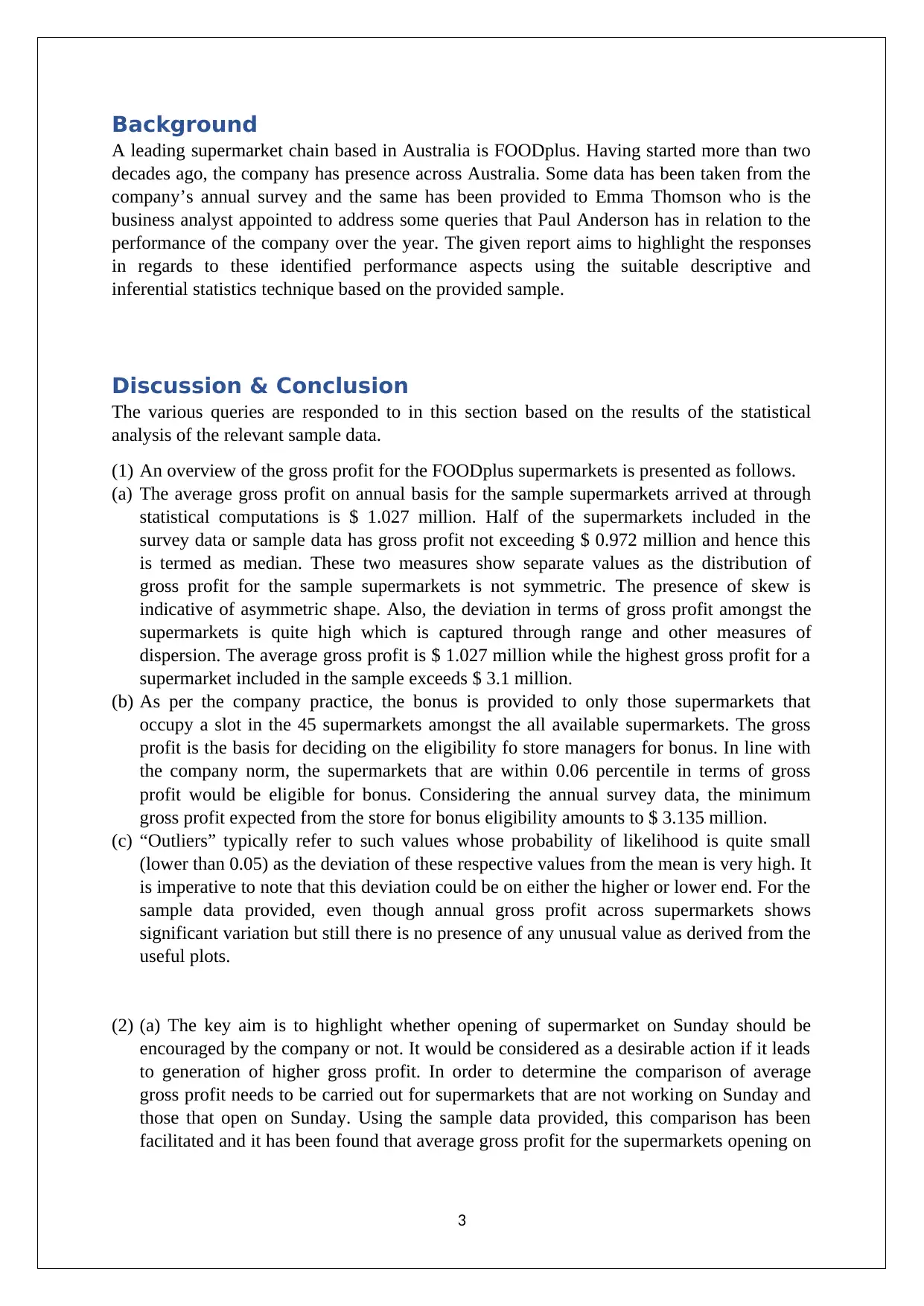
Background
A leading supermarket chain based in Australia is FOODplus. Having started more than two
decades ago, the company has presence across Australia. Some data has been taken from the
company’s annual survey and the same has been provided to Emma Thomson who is the
business analyst appointed to address some queries that Paul Anderson has in relation to the
performance of the company over the year. The given report aims to highlight the responses
in regards to these identified performance aspects using the suitable descriptive and
inferential statistics technique based on the provided sample.
Discussion & Conclusion
The various queries are responded to in this section based on the results of the statistical
analysis of the relevant sample data.
(1) An overview of the gross profit for the FOODplus supermarkets is presented as follows.
(a) The average gross profit on annual basis for the sample supermarkets arrived at through
statistical computations is $ 1.027 million. Half of the supermarkets included in the
survey data or sample data has gross profit not exceeding $ 0.972 million and hence this
is termed as median. These two measures show separate values as the distribution of
gross profit for the sample supermarkets is not symmetric. The presence of skew is
indicative of asymmetric shape. Also, the deviation in terms of gross profit amongst the
supermarkets is quite high which is captured through range and other measures of
dispersion. The average gross profit is $ 1.027 million while the highest gross profit for a
supermarket included in the sample exceeds $ 3.1 million.
(b) As per the company practice, the bonus is provided to only those supermarkets that
occupy a slot in the 45 supermarkets amongst the all available supermarkets. The gross
profit is the basis for deciding on the eligibility fo store managers for bonus. In line with
the company norm, the supermarkets that are within 0.06 percentile in terms of gross
profit would be eligible for bonus. Considering the annual survey data, the minimum
gross profit expected from the store for bonus eligibility amounts to $ 3.135 million.
(c) “Outliers” typically refer to such values whose probability of likelihood is quite small
(lower than 0.05) as the deviation of these respective values from the mean is very high. It
is imperative to note that this deviation could be on either the higher or lower end. For the
sample data provided, even though annual gross profit across supermarkets shows
significant variation but still there is no presence of any unusual value as derived from the
useful plots.
(2) (a) The key aim is to highlight whether opening of supermarket on Sunday should be
encouraged by the company or not. It would be considered as a desirable action if it leads
to generation of higher gross profit. In order to determine the comparison of average
gross profit needs to be carried out for supermarkets that are not working on Sunday and
those that open on Sunday. Using the sample data provided, this comparison has been
facilitated and it has been found that average gross profit for the supermarkets opening on
3
A leading supermarket chain based in Australia is FOODplus. Having started more than two
decades ago, the company has presence across Australia. Some data has been taken from the
company’s annual survey and the same has been provided to Emma Thomson who is the
business analyst appointed to address some queries that Paul Anderson has in relation to the
performance of the company over the year. The given report aims to highlight the responses
in regards to these identified performance aspects using the suitable descriptive and
inferential statistics technique based on the provided sample.
Discussion & Conclusion
The various queries are responded to in this section based on the results of the statistical
analysis of the relevant sample data.
(1) An overview of the gross profit for the FOODplus supermarkets is presented as follows.
(a) The average gross profit on annual basis for the sample supermarkets arrived at through
statistical computations is $ 1.027 million. Half of the supermarkets included in the
survey data or sample data has gross profit not exceeding $ 0.972 million and hence this
is termed as median. These two measures show separate values as the distribution of
gross profit for the sample supermarkets is not symmetric. The presence of skew is
indicative of asymmetric shape. Also, the deviation in terms of gross profit amongst the
supermarkets is quite high which is captured through range and other measures of
dispersion. The average gross profit is $ 1.027 million while the highest gross profit for a
supermarket included in the sample exceeds $ 3.1 million.
(b) As per the company practice, the bonus is provided to only those supermarkets that
occupy a slot in the 45 supermarkets amongst the all available supermarkets. The gross
profit is the basis for deciding on the eligibility fo store managers for bonus. In line with
the company norm, the supermarkets that are within 0.06 percentile in terms of gross
profit would be eligible for bonus. Considering the annual survey data, the minimum
gross profit expected from the store for bonus eligibility amounts to $ 3.135 million.
(c) “Outliers” typically refer to such values whose probability of likelihood is quite small
(lower than 0.05) as the deviation of these respective values from the mean is very high. It
is imperative to note that this deviation could be on either the higher or lower end. For the
sample data provided, even though annual gross profit across supermarkets shows
significant variation but still there is no presence of any unusual value as derived from the
useful plots.
(2) (a) The key aim is to highlight whether opening of supermarket on Sunday should be
encouraged by the company or not. It would be considered as a desirable action if it leads
to generation of higher gross profit. In order to determine the comparison of average
gross profit needs to be carried out for supermarkets that are not working on Sunday and
those that open on Sunday. Using the sample data provided, this comparison has been
facilitated and it has been found that average gross profit for the supermarkets opening on
3
Secure Best Marks with AI Grader
Need help grading? Try our AI Grader for instant feedback on your assignments.
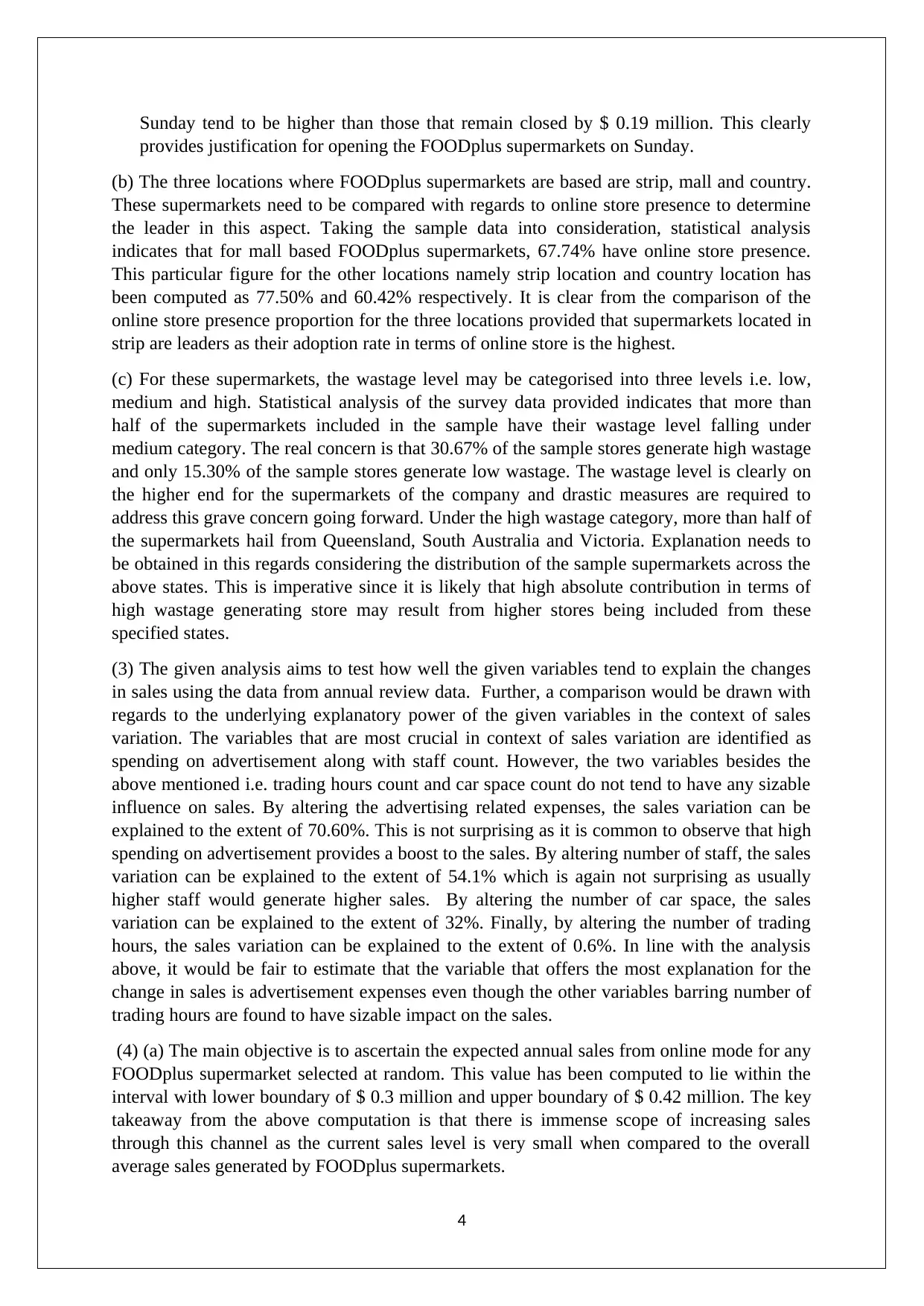
Sunday tend to be higher than those that remain closed by $ 0.19 million. This clearly
provides justification for opening the FOODplus supermarkets on Sunday.
(b) The three locations where FOODplus supermarkets are based are strip, mall and country.
These supermarkets need to be compared with regards to online store presence to determine
the leader in this aspect. Taking the sample data into consideration, statistical analysis
indicates that for mall based FOODplus supermarkets, 67.74% have online store presence.
This particular figure for the other locations namely strip location and country location has
been computed as 77.50% and 60.42% respectively. It is clear from the comparison of the
online store presence proportion for the three locations provided that supermarkets located in
strip are leaders as their adoption rate in terms of online store is the highest.
(c) For these supermarkets, the wastage level may be categorised into three levels i.e. low,
medium and high. Statistical analysis of the survey data provided indicates that more than
half of the supermarkets included in the sample have their wastage level falling under
medium category. The real concern is that 30.67% of the sample stores generate high wastage
and only 15.30% of the sample stores generate low wastage. The wastage level is clearly on
the higher end for the supermarkets of the company and drastic measures are required to
address this grave concern going forward. Under the high wastage category, more than half of
the supermarkets hail from Queensland, South Australia and Victoria. Explanation needs to
be obtained in this regards considering the distribution of the sample supermarkets across the
above states. This is imperative since it is likely that high absolute contribution in terms of
high wastage generating store may result from higher stores being included from these
specified states.
(3) The given analysis aims to test how well the given variables tend to explain the changes
in sales using the data from annual review data. Further, a comparison would be drawn with
regards to the underlying explanatory power of the given variables in the context of sales
variation. The variables that are most crucial in context of sales variation are identified as
spending on advertisement along with staff count. However, the two variables besides the
above mentioned i.e. trading hours count and car space count do not tend to have any sizable
influence on sales. By altering the advertising related expenses, the sales variation can be
explained to the extent of 70.60%. This is not surprising as it is common to observe that high
spending on advertisement provides a boost to the sales. By altering number of staff, the sales
variation can be explained to the extent of 54.1% which is again not surprising as usually
higher staff would generate higher sales. By altering the number of car space, the sales
variation can be explained to the extent of 32%. Finally, by altering the number of trading
hours, the sales variation can be explained to the extent of 0.6%. In line with the analysis
above, it would be fair to estimate that the variable that offers the most explanation for the
change in sales is advertisement expenses even though the other variables barring number of
trading hours are found to have sizable impact on the sales.
(4) (a) The main objective is to ascertain the expected annual sales from online mode for any
FOODplus supermarket selected at random. This value has been computed to lie within the
interval with lower boundary of $ 0.3 million and upper boundary of $ 0.42 million. The key
takeaway from the above computation is that there is immense scope of increasing sales
through this channel as the current sales level is very small when compared to the overall
average sales generated by FOODplus supermarkets.
4
provides justification for opening the FOODplus supermarkets on Sunday.
(b) The three locations where FOODplus supermarkets are based are strip, mall and country.
These supermarkets need to be compared with regards to online store presence to determine
the leader in this aspect. Taking the sample data into consideration, statistical analysis
indicates that for mall based FOODplus supermarkets, 67.74% have online store presence.
This particular figure for the other locations namely strip location and country location has
been computed as 77.50% and 60.42% respectively. It is clear from the comparison of the
online store presence proportion for the three locations provided that supermarkets located in
strip are leaders as their adoption rate in terms of online store is the highest.
(c) For these supermarkets, the wastage level may be categorised into three levels i.e. low,
medium and high. Statistical analysis of the survey data provided indicates that more than
half of the supermarkets included in the sample have their wastage level falling under
medium category. The real concern is that 30.67% of the sample stores generate high wastage
and only 15.30% of the sample stores generate low wastage. The wastage level is clearly on
the higher end for the supermarkets of the company and drastic measures are required to
address this grave concern going forward. Under the high wastage category, more than half of
the supermarkets hail from Queensland, South Australia and Victoria. Explanation needs to
be obtained in this regards considering the distribution of the sample supermarkets across the
above states. This is imperative since it is likely that high absolute contribution in terms of
high wastage generating store may result from higher stores being included from these
specified states.
(3) The given analysis aims to test how well the given variables tend to explain the changes
in sales using the data from annual review data. Further, a comparison would be drawn with
regards to the underlying explanatory power of the given variables in the context of sales
variation. The variables that are most crucial in context of sales variation are identified as
spending on advertisement along with staff count. However, the two variables besides the
above mentioned i.e. trading hours count and car space count do not tend to have any sizable
influence on sales. By altering the advertising related expenses, the sales variation can be
explained to the extent of 70.60%. This is not surprising as it is common to observe that high
spending on advertisement provides a boost to the sales. By altering number of staff, the sales
variation can be explained to the extent of 54.1% which is again not surprising as usually
higher staff would generate higher sales. By altering the number of car space, the sales
variation can be explained to the extent of 32%. Finally, by altering the number of trading
hours, the sales variation can be explained to the extent of 0.6%. In line with the analysis
above, it would be fair to estimate that the variable that offers the most explanation for the
change in sales is advertisement expenses even though the other variables barring number of
trading hours are found to have sizable impact on the sales.
(4) (a) The main objective is to ascertain the expected annual sales from online mode for any
FOODplus supermarket selected at random. This value has been computed to lie within the
interval with lower boundary of $ 0.3 million and upper boundary of $ 0.42 million. The key
takeaway from the above computation is that there is immense scope of increasing sales
through this channel as the current sales level is very small when compared to the overall
average sales generated by FOODplus supermarkets.
4
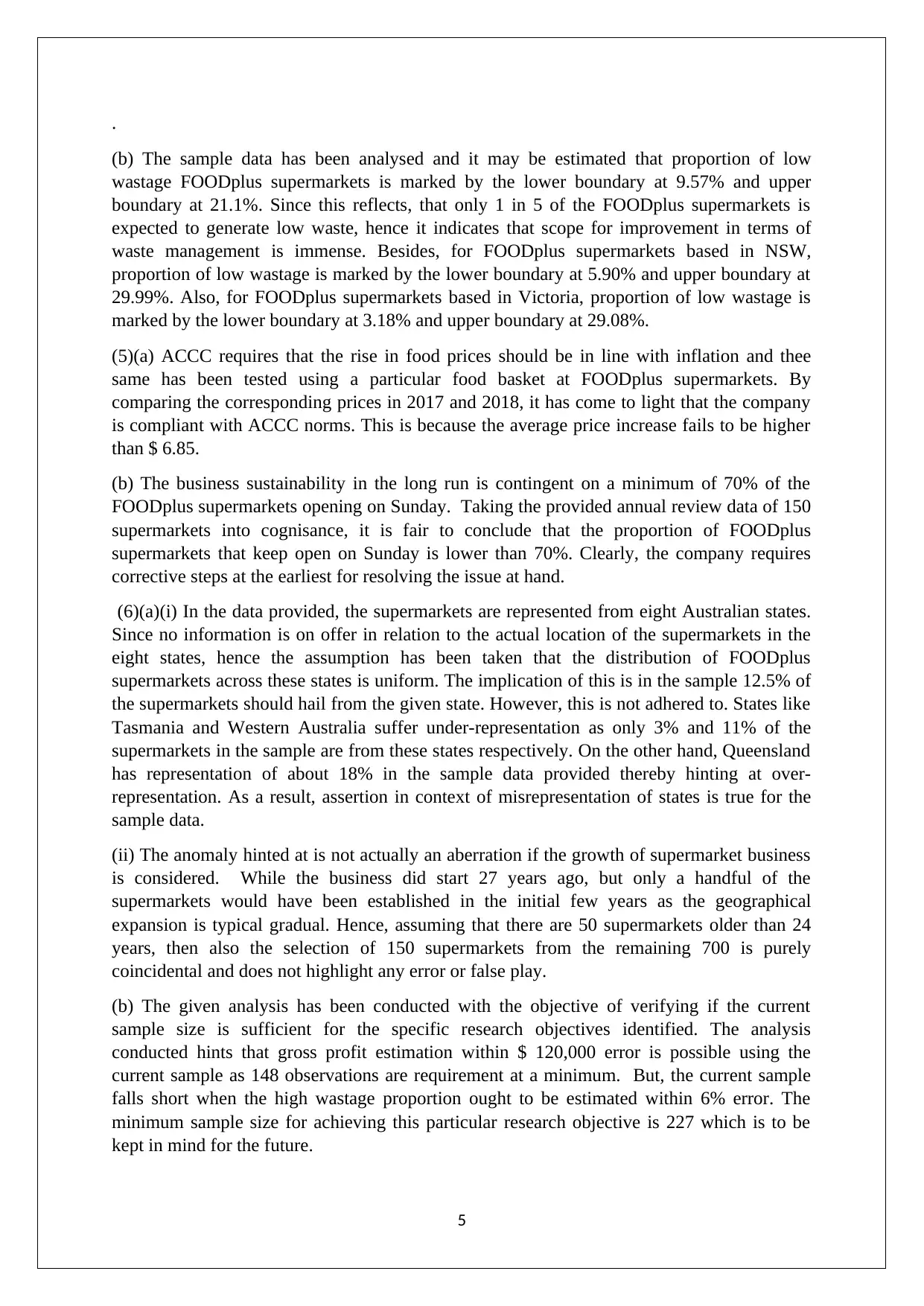
.
(b) The sample data has been analysed and it may be estimated that proportion of low
wastage FOODplus supermarkets is marked by the lower boundary at 9.57% and upper
boundary at 21.1%. Since this reflects, that only 1 in 5 of the FOODplus supermarkets is
expected to generate low waste, hence it indicates that scope for improvement in terms of
waste management is immense. Besides, for FOODplus supermarkets based in NSW,
proportion of low wastage is marked by the lower boundary at 5.90% and upper boundary at
29.99%. Also, for FOODplus supermarkets based in Victoria, proportion of low wastage is
marked by the lower boundary at 3.18% and upper boundary at 29.08%.
(5)(a) ACCC requires that the rise in food prices should be in line with inflation and thee
same has been tested using a particular food basket at FOODplus supermarkets. By
comparing the corresponding prices in 2017 and 2018, it has come to light that the company
is compliant with ACCC norms. This is because the average price increase fails to be higher
than $ 6.85.
(b) The business sustainability in the long run is contingent on a minimum of 70% of the
FOODplus supermarkets opening on Sunday. Taking the provided annual review data of 150
supermarkets into cognisance, it is fair to conclude that the proportion of FOODplus
supermarkets that keep open on Sunday is lower than 70%. Clearly, the company requires
corrective steps at the earliest for resolving the issue at hand.
(6)(a)(i) In the data provided, the supermarkets are represented from eight Australian states.
Since no information is on offer in relation to the actual location of the supermarkets in the
eight states, hence the assumption has been taken that the distribution of FOODplus
supermarkets across these states is uniform. The implication of this is in the sample 12.5% of
the supermarkets should hail from the given state. However, this is not adhered to. States like
Tasmania and Western Australia suffer under-representation as only 3% and 11% of the
supermarkets in the sample are from these states respectively. On the other hand, Queensland
has representation of about 18% in the sample data provided thereby hinting at over-
representation. As a result, assertion in context of misrepresentation of states is true for the
sample data.
(ii) The anomaly hinted at is not actually an aberration if the growth of supermarket business
is considered. While the business did start 27 years ago, but only a handful of the
supermarkets would have been established in the initial few years as the geographical
expansion is typical gradual. Hence, assuming that there are 50 supermarkets older than 24
years, then also the selection of 150 supermarkets from the remaining 700 is purely
coincidental and does not highlight any error or false play.
(b) The given analysis has been conducted with the objective of verifying if the current
sample size is sufficient for the specific research objectives identified. The analysis
conducted hints that gross profit estimation within $ 120,000 error is possible using the
current sample as 148 observations are requirement at a minimum. But, the current sample
falls short when the high wastage proportion ought to be estimated within 6% error. The
minimum sample size for achieving this particular research objective is 227 which is to be
kept in mind for the future.
5
(b) The sample data has been analysed and it may be estimated that proportion of low
wastage FOODplus supermarkets is marked by the lower boundary at 9.57% and upper
boundary at 21.1%. Since this reflects, that only 1 in 5 of the FOODplus supermarkets is
expected to generate low waste, hence it indicates that scope for improvement in terms of
waste management is immense. Besides, for FOODplus supermarkets based in NSW,
proportion of low wastage is marked by the lower boundary at 5.90% and upper boundary at
29.99%. Also, for FOODplus supermarkets based in Victoria, proportion of low wastage is
marked by the lower boundary at 3.18% and upper boundary at 29.08%.
(5)(a) ACCC requires that the rise in food prices should be in line with inflation and thee
same has been tested using a particular food basket at FOODplus supermarkets. By
comparing the corresponding prices in 2017 and 2018, it has come to light that the company
is compliant with ACCC norms. This is because the average price increase fails to be higher
than $ 6.85.
(b) The business sustainability in the long run is contingent on a minimum of 70% of the
FOODplus supermarkets opening on Sunday. Taking the provided annual review data of 150
supermarkets into cognisance, it is fair to conclude that the proportion of FOODplus
supermarkets that keep open on Sunday is lower than 70%. Clearly, the company requires
corrective steps at the earliest for resolving the issue at hand.
(6)(a)(i) In the data provided, the supermarkets are represented from eight Australian states.
Since no information is on offer in relation to the actual location of the supermarkets in the
eight states, hence the assumption has been taken that the distribution of FOODplus
supermarkets across these states is uniform. The implication of this is in the sample 12.5% of
the supermarkets should hail from the given state. However, this is not adhered to. States like
Tasmania and Western Australia suffer under-representation as only 3% and 11% of the
supermarkets in the sample are from these states respectively. On the other hand, Queensland
has representation of about 18% in the sample data provided thereby hinting at over-
representation. As a result, assertion in context of misrepresentation of states is true for the
sample data.
(ii) The anomaly hinted at is not actually an aberration if the growth of supermarket business
is considered. While the business did start 27 years ago, but only a handful of the
supermarkets would have been established in the initial few years as the geographical
expansion is typical gradual. Hence, assuming that there are 50 supermarkets older than 24
years, then also the selection of 150 supermarkets from the remaining 700 is purely
coincidental and does not highlight any error or false play.
(b) The given analysis has been conducted with the objective of verifying if the current
sample size is sufficient for the specific research objectives identified. The analysis
conducted hints that gross profit estimation within $ 120,000 error is possible using the
current sample as 148 observations are requirement at a minimum. But, the current sample
falls short when the high wastage proportion ought to be estimated within 6% error. The
minimum sample size for achieving this particular research objective is 227 which is to be
kept in mind for the future.
5
1 out of 6
Related Documents
Your All-in-One AI-Powered Toolkit for Academic Success.
+13062052269
info@desklib.com
Available 24*7 on WhatsApp / Email
![[object Object]](/_next/static/media/star-bottom.7253800d.svg)
Unlock your academic potential
© 2024 | Zucol Services PVT LTD | All rights reserved.





